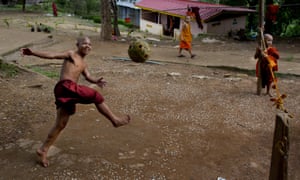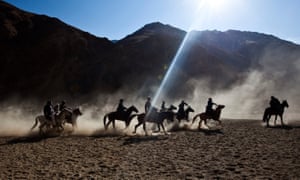
1) Gurning
The sport of gurning has been practised in the United Kingdom for more than 700 years, though is referred to by other names in other territories; in the US they call it “making a face” while continental Europeans prefer “looking British”. Gurning’s most famous event is its world championship, which takes place at the Egremont Crab Fair in Cumbria. Though the sport is probably not as old as the event, which has been going since 1267, it was described as an “ancient tradition” as early as 1852; arguably, nothing is more quintessentially English.
Traditionally, competitors frame their chiselled phizogs with a horse halter known as a “braffin” before performing the gurn. This involves using the bottom lip to grip as much upper face as possible, not dissimilar to the pouting duck-face so beloved of the selfie generation. Contestants are ordered to “snarl like a dog, look savage, distort the countenance” and are banned from wearing make-up, though as with competitors in similar disciplines such as boxing, diving and gymnastics, they cannot legislate for the impressionistic scoring that decides their fate. And like boxers, divers and gymnasts, they have only one remedy: hard work. “Gold-medal gurners,” wrote JR Daeschner, “train like Olympic champions, experimenting with different faces until they hit on a suitably ugly mug.”
Take Peter Jackman, for example. Famed for the “Bela Lugosi” face that he named after the original Count Dracula, he won three consecutive world titles between 1996 and 1998, but after Tommy Mattinson came back at him in 1999, Jackman had his teeth removed, granting his gums crucial extra leverage. And the decision reaped rich reward when he reclaimed his crown in 2000, though Mattinson has prevailed 13 times since then and 16 times in total.
But even Mattinson’s achievements are eclipsed by those of the late, great Anne Woods. Born in Egremont, she first gurned in 1977, and her commitment to her art was such that in 2010 she was rushed to hospital … after the exertion of winning her 27th world title. “I am considering retiring,” she said afterwards, “but I know what I’m like. Come next year’s competition, I’ll be itching to get on stage again.” And she was right; she was there in 2011, and in 2014 increased her tally to an incredible 28, before passing away the following spring.
Sadly it has been a tricky week for grassroots gurning. The enforced closure of London’s Fabric nightclub has robbed the sport of a most fertile breeding ground, a venue where thousands of keen amateurs could meet to hone their craft. No doubt, all those affected will simply throw their faces away and never enjoy pulling them again. Well, either that, or they’ll simply find somewhere else to go; somewhere such as Egremont Crab Fair which, by wondrous coincidence, is happening on Saturday – enjoy! DH
2) Ferret legging
The kind of sport that might feature on Last of the Summer Wine, Countryfile or as a feature introduced by Gyles Brandreth on The One Show, the sport of ferret-legging is a test of endurance in which competitors take turns to securely tie their trousers at the ankles, introduce a pair of vicious, red-eyed foot-long carnivores and then yank their belts tight to prevent the animals from escaping. Standing in front of a panel of judges, participants compete to see who can withstand the pain of the subsequent escape attempts the longest. While the one-minute mark was long considered a milestone for “keeping ’em down”, the world record for ferret legging is an astonishing five hours and 26 minutes and is held by the late Reg Mellor, a native of Barnsley who pulled off his heroic feat in 1981, in front of 5,000 witnesses at the Annual Pennine Show in Holmfirth, West Yorkshire.
The history of ferret legging is unclear but the sport is believed to have originated in Britain, at a time when poachers who used to send their animals down rabbit warrens to scare out the occupants were obliged to smuggle their furry assistants past gamekeepers by hiding them in their trousers. As a test of manliness and a feat of sporting endurance, the practice became popular among Yorkshire miners during the 1970s but has since waned in popularity. Mellor may have shuffled, trousers bulging, off this mortal coil but his legacy looks likely to remain intact for eternity.
The rules of the sport are simple, and no great finesse or skill beyond the capacity to endure extreme pain is required. All involved must be sober and sedative-free. Each competitor must wear baggy trousers to allow free movement of the ferrets from one leg to the other with a minimum of fuss. Competitors are also obliged to go commando and are forbidden from wearing underpants, jockstraps or protective clothing of any kind. And, while controversy remains about how much stress the ferrets are subjected to, there are some protections in place: each animal must have a full set of fangs which cannot have been be filed, and all claws must be unclipped. As for the physical and mental fortitude required to be a successful ferret legger? “You’ve just got be able ta have your tool bitten and not care,” Mellor once explained to a curious American interviewer. BG

3) Sepak takraw
There are few games more simple to grasp than volleyball. It has two teams, a ball and a net with a clear objective. But imagine swapping your hands for your feet to get a ball historically made of rattan rather than leather over the net – then you have sepak takraw. The sport originated around the 15th century in south-east Asia and is now played in more than 100 countries, including the UK and US (seemingly brought to both by Asian students), though of course in both instances it is not especially well-participated in.
Its popularity in Asia, however, is perhaps at its greatest level ever and, though professionally it is played on badminton-like courts, minimal equipment plus an ability to improvise makes it accessible for all. Thailand are currently the world’s best team, with Malaysia, Singapore and Japan also strong. Indeed it is the national sport of Malaysia and commands significant media attention – in stark contrast to the focus it has received in the western world. In 2011 a deal was struck with Eurosport to broadcast the ISTAF World Cup but the agreement was not renewed.

While the sport dates back more than 500 years, with several countries disputing who started it, the first known set of rules did not appear until 1829, written by the Siam Sports Association. Four years later the net was added but it was not until 1965 that international competition was formed, five years after the Asian federation was established. Efforts have also been made for sepak takraw to become an Olympic sport, but the campaign has fallen on deaf ears at the IOC. It has nonetheless featured prominently at the Asian Games, which are also held on a four-year cycle, since 1990 – Malaysia won the first two but the subsequent five titles have gone to Thailand. AS
4) Buzkashi
Traditionally played during the winter and early spring, Buzkashi is the national sport of Afghanistan in which players on horseback attempt to get the headless, disembowelled carcass of a goat or calf weighing up to 160lbs into a goal or scoring circle on a square pitch measuring 400 metres on each side. Literally translated as “goat grabbing”, the sport has two variations: Quarajai, and Tudabarai, with both having similar objectives even if the rules of the former are more complicated. To take part in this extremely violent game, the horses, bred specially for the sport, and riders must undergo years of intensive training. Games could often last up to five days but are now restricted to two halves of 45 minutes by rules introduced by the Afghan Olympic Federation. These rules, which also dictate that each team has 10 members, are only adhered to in matches staged in Kabul.

Just as footballers tend to reach their peak in their mid to late 20s, the best Buzkashi riders tend to be men in their 40s, while the importance of their horses cannot be understated. “Better a poor rider on a good horse than a good rider on a poor horse,” say the Afghans. The most successful Buzkashi competitors are sponsored by wealthy patrons, while the prizes on offer include money or expensive clothes. Arguably the most famous practitioner of the sport is Sylvester Stallone, who took to it like a duck to water in Rambo III. Injuries are common, but players are expected to continue with broken ribs, head injuries and assorted other ailments as quitting is considered a sign of weakness.
Perhaps because spectators like to gamble on Buzkashi, the sport was banned for the duration of the Taliban regime in Afghanistan, on the grounds that the rulers found it immoral. Confiscating the horses of those who played the sport, they put them to work at the moral job of helping the military instead. BG
5) Quidditch
And you thought it was just a fictional sport in a series of books about wizards. No, the JK Rowling creation (well, a variation of it) is actually played by humans (or should that be muggles?). It even has a governing body – the International Quidditch Association was founded in 2009. The real-life sport, stemming from Harry Potter, was first created by Xander Manshel and Alex Benepe in Vermont, in the US, in 2005 on what the IQA says was a “sunny Sunday afternoon”, but there are now more than 20 national governing bodies and a World Cup, which is played every two years. The first was held in Oxford in 2012 and USA took the title before retaining it in 2014. However, Australia beat them 150-0 in Frankfurt this year.

To the uninitiated that score seems like an almighty walloping, but the primary aim is to catch the snitch, which is usually a tennis ball hidden in a sock, attached to an impartial official dressed in yellow. That results in 30 points, while goals – scored with the quaffle, which is really a volleyball with a bit of air taken out of it, in three different hoops – are worth 10. There are seven players on each team with rolling substitutes. They are made up of chasers (who pass and score with the quaffle), keepers (self-explanatory), beaters (tasked with attacking the chasers with balls called bludgers) and seekers (whose sole objective is to catch the snitch, entering the field after 18 minutes of action). Meanwhile, each player must hold a broomstick between their legs to play the balls. Confused? This might help. AS
6) Takanakuy
The willingness of humans to cause each other pain is remarkable; consider, for example, the ratio of martial arts, many, to marital arts, one. But the willingness of humans to cause pain to those they love most is a category in itself – which is where Takanakuy comes in. Named for a Quechuan word that literally means “when the blood is boiling”, Takanakuy was invented in Peru’s Andean city of Santo Tomás as a means to settle disputes. Because the residents were so isolated, they had no access to usual forms of justice, deciding to settle things according to the logical and moral certainty of a scrap.
Since then things have moved on, and Takanakuy, also a festival of music, dancing and skinfuls, is now a Christmas Day treat for the indigenous folk of Chumbivilcas Province. Though its population is around 300, closer to 3,000 gather for the fighting, the birth of the Lord saviour honoured by the knocking of seven shades out of various family members – or anyone else with whom exists residual beef. So wear that Christmas jumper if you must; watch the Queen’s speech, sure; even refuse to refer to the turkey as anything but a “bird”; just know that if you do, the hour of reckoning will come.
Naturally, Takanakuy is an egalitarian affair, with men, women and children all partaking. Celebrants dress in colourful attire, wearing ski masks, special belts and even stuffed animal hats; men must wrap their hands. Then they take to the ring, made out of everyone they know, and dish out windmill punches and kicks until someone falls down. The rules are beautiful in their simplicity: no biting, no booting someone when they’re down, have fun! Any infringements are dealt with in the first instance by a referee armed with a colourful whip – no doubt the sensation is like being hit with a rainbow – but police are also in attendance in case things get out of hand because, amazingly, aunties pagga-ing is deemed perfectly fine.
As you’d expect, the simple brilliance of the idea has seen it spread to larger cities, with punters in Lima and Cuzco adopting the custom; prepare to wince and cheer in equal measure upon discovering its cultural appropriation by attention-seeking hipsters near you. DH
[Source:-The Guardian]]






